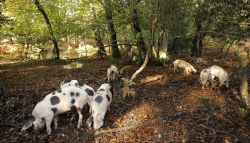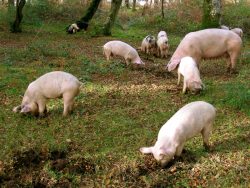 AWARD-winning charcutier David Richards of Capreolus Fine Foods at Rampisham in West Dorset has created a new product which follows in a tradition dating back nearly 1,000 years – the commoners’ right of Mast (or pannage) in the New Forest.
AWARD-winning charcutier David Richards of Capreolus Fine Foods at Rampisham in West Dorset has created a new product which follows in a tradition dating back nearly 1,000 years – the commoners’ right of Mast (or pannage) in the New Forest.
Working with New Forest commoner and farmer Jonny Burrell, David is producing New Forest Pannage Ham, and has applied to the agriculture and environment ministry, DEFRA, for the new GI (Geographical Indication) accreditation, which replaces the EU’s PDO (Protected Designation of Origin).
The new product, which is already gaining warm approval from chefs and food experts, is a worthy competitor for the famous Spanish Jamon de Bellota, generally regarded as the world’s finest ham. Charlie Turnbull, the founder of Delishops Discover, described it as “proper stuff – the flavour is unique and the fat just melts.”
Unique is the right word – New Forest Pannage Ham is an air-dried ham, but not as we know it. It is delicate but deeply flavoured, earthy and slightly smoky.
 Pannage is the name for the right of New Forest Commoners to let their pigs out on to the forest in the autumn-winter season to eat acorns and beech mast. It is a beneficial right for the commoners in terms of “free” food for their stock and a safety measure to protect the New Forest’s wild ponies and commoners’ cattle from being poisoned by eating acorns.
Pannage is the name for the right of New Forest Commoners to let their pigs out on to the forest in the autumn-winter season to eat acorns and beech mast. It is a beneficial right for the commoners in terms of “free” food for their stock and a safety measure to protect the New Forest’s wild ponies and commoners’ cattle from being poisoned by eating acorns.
It also produces pork and ham with a uniquely deep and delicious taste, which David Richards believes is an ideal English alternative to Spain’s Jamon Iberico.
David has written the specifications for the GI application. There is no single pig breed used for the production of New Forest Pannage Ham but most are traditional English rare breeds, including British Lop, Gloucester Old Spot, Tamworth, Oxford Sandy & Black, British Saddleback, Large White, Middle White, Large Black, Berkshire and British Landrace.
Pannage Ham is made using the boned leg above the knee skinned and trimmed to give a ‘tear-drop’ shape. It is cured with a curing salt containing a nitrate/nitrite salt (sodium chloride content in finished ham not to exceed 5% and nitrate/nitrite level not to exceed 200ppm), spices, and herbs. The pigs must be born, reared and fattened within the defined geographical area and only the legs of ‘Pannage Pigs’ released into the New Forest during the pannage season (determined by the New Forest Verderers) can be used. The pigs must be slaughtered within two months of the end of the pannage season to ensure that the flavour imparted by the diet of acorns and other foraged food is maintained. The time from the start of curing to the end of the air-drying phase is a minimum of 12 months.
 The New Forest – Nova Foresta – was founded by William the Conqueror in 1079 as a royal hunting forest. Hunting – mainly deer and wild boar – was doubtless enjoyed by the Anglo Saxons, the Romans and others, but it was the Normans who were most obsessed with it. Under the Norman kings, large areas of the countryside, particularly in the southern half of England, were designated as “Royal Forests” (also Kingswood) with forest laws applied to protect the venison and the vert (the greenery that sustained the deer). The major surviving forests are the New Forest, the Forest of Dean, Sherwood Forest and Epping Forest; in the West Country, there were royal forests on Cranborne Chase, around Gillingham, Mendip, Selwood, and both Exmoor and Dartmoor.
The New Forest – Nova Foresta – was founded by William the Conqueror in 1079 as a royal hunting forest. Hunting – mainly deer and wild boar – was doubtless enjoyed by the Anglo Saxons, the Romans and others, but it was the Normans who were most obsessed with it. Under the Norman kings, large areas of the countryside, particularly in the southern half of England, were designated as “Royal Forests” (also Kingswood) with forest laws applied to protect the venison and the vert (the greenery that sustained the deer). The major surviving forests are the New Forest, the Forest of Dean, Sherwood Forest and Epping Forest; in the West Country, there were royal forests on Cranborne Chase, around Gillingham, Mendip, Selwood, and both Exmoor and Dartmoor.
In the New Forest, the predominant native trees are the oak and beech. There are estimated to be around 1,000 ancient (over 400 years) oaks in the forest, the oldest of which is the Knightwood Oak, believed to be more than 500 years old. Many big oaks were felled in the 17th and 18th century for ship building; new trees were planted in the early 19th century.
The Normans imposed punitive laws governing the royal forest, but there were also Commoners Rights (attached to properties not people), which include Pasture, Mast and Fuelwood.or Estovers; (Marl, cutting clay, and Turbary, cutting peat, are discontinued). The Common of Pasture is the right to turn out cattle, ponies, donkeys and mules to graze; the Common of Mast is the right to turn out pigs during the Pannage season, a period of not less than 60 days, fixed by the Verderers. It can be extended (as it was last year) depending on the volume of acorns and beech mast.
Pannage used to be common throughout the UK but now only continues in the New Forest. Eating acorns leads to a firmer, darker and more ‘gamey’ flesh than that from pigs raised under modern farming conditions.
This new Capreolus product will have a relatively short annual season. As David says, “When it’s gone, it’s gone.” So look out for New Forest Pannage Ham at your local deli or on restaurant menus, and sample this very special taste of old English oaks and traditional English pigs.